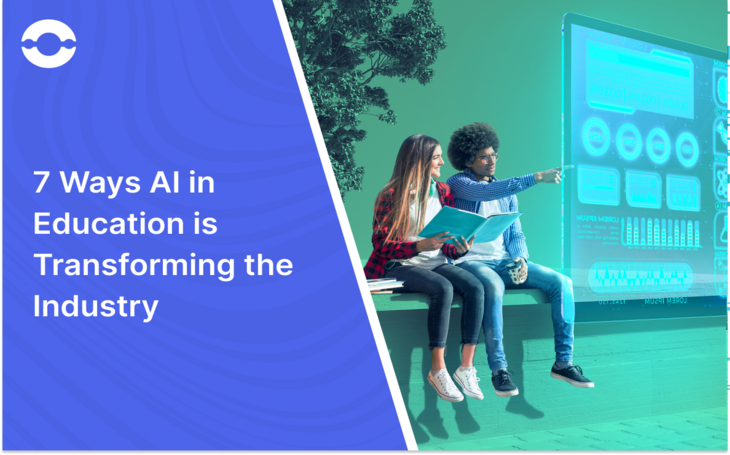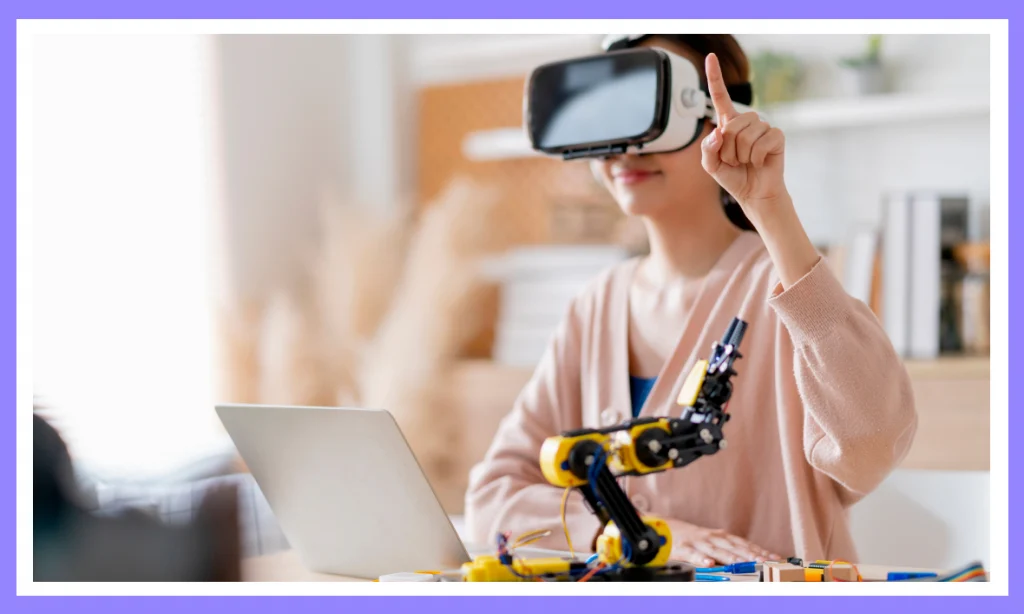
Artificial Intelligence (AI) has penetrated multiple industries/sectors due to its myriad benefits. Education is one such sector that has leveraged AI to expand its scope. AI in education is transforming the way young, budding minds are shaped. Education is boundary-less, and students have more learning and course options than ever before.
Therefore, AI in education has been a boon so far, and let’s hope that the ambit and reach of education widens, as AI advances and expands in possibilities.

Starting with the basics, let’s learn a bit about AI and then straight jump on to the ways it is transforming the education industry.
What is AI?
Artificial Intelligence or AI is an emerging technology that combines computer science and datasets, to facilitate problem-solving.
A concept that has formally been around since the 1950s, has grown by leaps and bounds in its capabilities. Traditionally defined as a machine’s ability to undertake a task that would’ve previously required human intelligence, the definition of AI broadened over the years.
Contemporary AI solutions are believed to perform tasks that are generally associated with human cognitive functions. These functions include, inter alia, interpreting speech, and spotting patterns. The more these solutions are exposed to data, the sharper they become in severing the purpose.
AI comes in multiple forms and devices. AI-powered conversational chatbots such as Bard and ChatGPT, Google Maps, smart assistants, wearables, etc., are some examples of AI.
Let’s now have a look at how the education sector is leveraging artificial intelligence in teaching and learning.
7 Ways AI in Education is Transforming the Industry
Research points out that the global AI in the education market will reach US$ 12 billion by 2027 at a CAGR of 45% between 2022-27.

Let’s look at for what all tasks and aspects of the education sector that are enhanced with the use of AI:
1. Automation of Tedious Tasks
AI in education helps institutions and employees to automate the reoccurring, mundane administrative or organizational tasks, allowing them to focus on more key teaching activities. Further, this also helps to bring efficiency in tasks and eliminate the room for human error.
These tasks include grading tests, evaluating assignments and homework, filing the required paperwork, preparing performance reports, and managing and organizing teaching resources and materials for classes or lectures.
2. Accessibility Around the World
With the use of AI in the education sector, learning transcends boundaries. The technology of AI has made remote learning possible and more effective. Additionally, it has opened new learning gates for students who want to learn a specific subject or course but couldn’t do so earlier due to geographical or resource constraints.
Further, educational classrooms become more accessible and inclusive with AI. Students with hearing or visual impairments or who speak a different language could also learn through AI tools. PowerPoint plugins such as Presentation Translator, provide students with real-time subtitles of the lesson being taught.
Moreover, accessing AI-powered education is also a decent task. Students are provided with material that equips them with fundamental IT skills.
3. Adaptive and Personalized Learning
Adaptive learning, a part of personalized learning, is a machine-supported system that caters to the needs of each learner. This helps in addressing or targeting the unique needs of an individual and focuses on his/her personal growth.
AI enables institutions to leverage personalized learning, allowing them to offer exactly what each student wants and needs in order to learn and grow. The technology adjusts to every student’s capacity to absorb concepts and offers services according to his/her learning speed, goals, and interests.
As per research, personalized learning can improve student achievement irrespective of their starting level.
4. Facilitating faster course and learning improvements
AI is filling gaps in the classroom and virtual learning by sending alerts to professors and students about the concepts that need to be retaught or relearned.
Coursera, for example, has been leveraging AI to send hints to students for answers they are struggling with and at the same time, to teachers/professors about the improvements required for a particular topic. Moreover, it also offers additional support and material to students, right away, to understand the concept better.
This ensures that every student has a strong conceptual base, which is crucial for the future in-depth understanding of a concept.
Additionally, AI-powered solutions can analyze each student’s learning history, identify and highlight weaknesses, and offer courses suitable for improvement. This also helps with personalized learning.
5. Smart content
Smart content is no more restricted to businesses. It has entered the realm of education as well. Robots, video conferencing, lectures, digital books, videos, instructional snippets, etc., are all different types of smart content to make education and learning a more comprehensive, polished, and customizable activity.
New digital learning interfaces are helping students to customize and personalize their learning curve, across all academic grades and ages.
Cram101, a learning mechanism, makes use of AI to make content more digestible and easier to navigate. It provides students with chapter or topic summaries, flashcards, practice tests, etc.
Another AI interface that makes content more visual and absorbable for students is Netex Learning. It enables teachers and professors to create digital curriculums and other resources or material, across multiple devices. It offers digital assistance programs, audio, as well as illustrative videos.
6. Better in-class learning
AI can help teachers or professors to spot some of the weaknesses within a classroom more efficiently. This includes pointing out when students miss a particular question. A teacher right away gets notified, and thus, can identify topics that need to be explained in a different and better way.
This helps to make the classroom teaching and the overall education system, a bit more accountable, ensuring the best teaching practices are being implemented inside a classroom.
7. Around-the-clock assistance
AI allows students to learn, make mistakes, and learn again, all the time, from anywhere. With AI chatbots offering 24*7 assistance, students can start and continue with their learning at a time of convenience, after school/college hours. This can be done without worrying about getting stuck in a concept and waiting till the next day to get the answers.
Conclusion
Therefore, similar to AI in other sectors, AI in the education sector offers enhanced efficiency, comfort, and innovation, eliminating hassles of any kind. It helps to impart knowledge using visually and mentally engaging learning methods, making information last for much longer durations. It is shaping minds for a brighter and better future.
With the pace at which technology is advancing, AI would soon help students be much more confident about their present as well as future academic decisions, enhancing the overall productivity in classrooms, and jobs.
How BigOh can help?
BigOhTech is a well-known name in the tech industry. We offer services such as custom software development, app and web development, staff augmentation, emerging technologies, etc.
Our dedicated development team of AI/ML developers build data-driven models, combined with advanced ML algorithms, that help them to do better analysis, study patterns and offer insightful feedback.
So, make learning a better experience for your students today!
FAQs
AI in the education industry is benefiting in the following ways:
1. Personalized learning experience
2. Increased engagement and better mental concept retention among students through digital learning methods
3. Better insights into student performance and progress through data analytics
4. Automation of administrative tasks and processes such as scheduling and grading
5. More accessible global learning
With AI, teachers or professors can focus more on the teaching part, with the technology taking care of the repetitive tasks.
Furthermore, students can understand and learn better with more digital content being generated using AI. They can learn anytime, from anywhere they want with constant assistance from the AI-powered chatbots.
AI makes education and learning a more personalized concept, with teachers being able to better identify the gaps in student learning and students being able to absorb the concepts that give them a hard time or that interest them, faster and better.
AI chatbots are transforming mobile technology in the following ways:
1. Improved user experience with chatbots
2. Personalized experience
3. Ease of navigation with faster product or content search
To know more about how AI is improving mobile technology, read through our blog.




